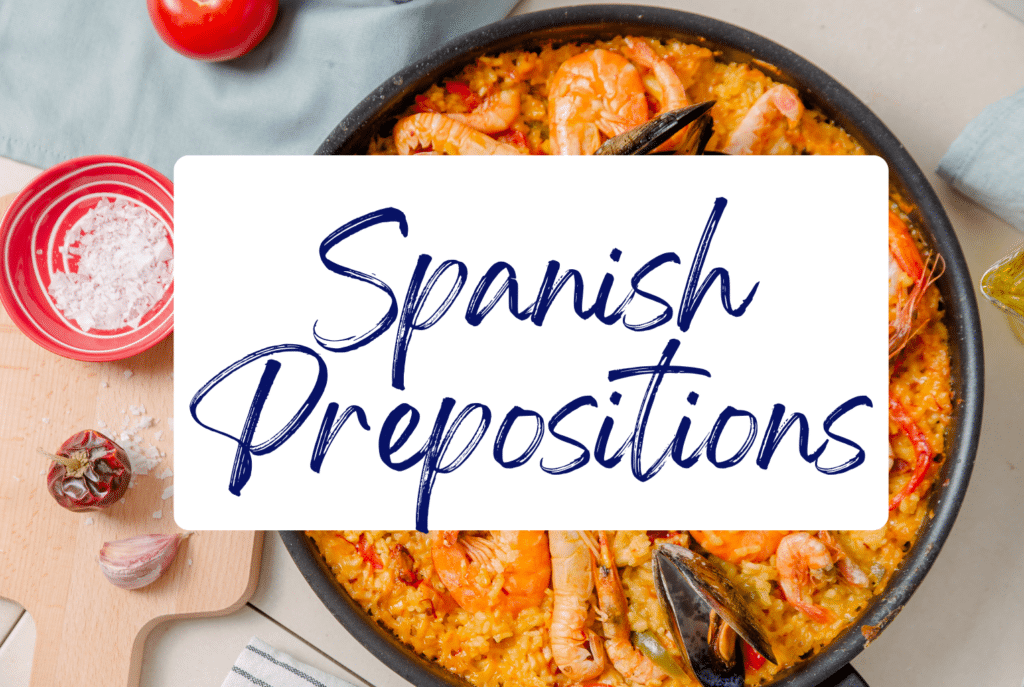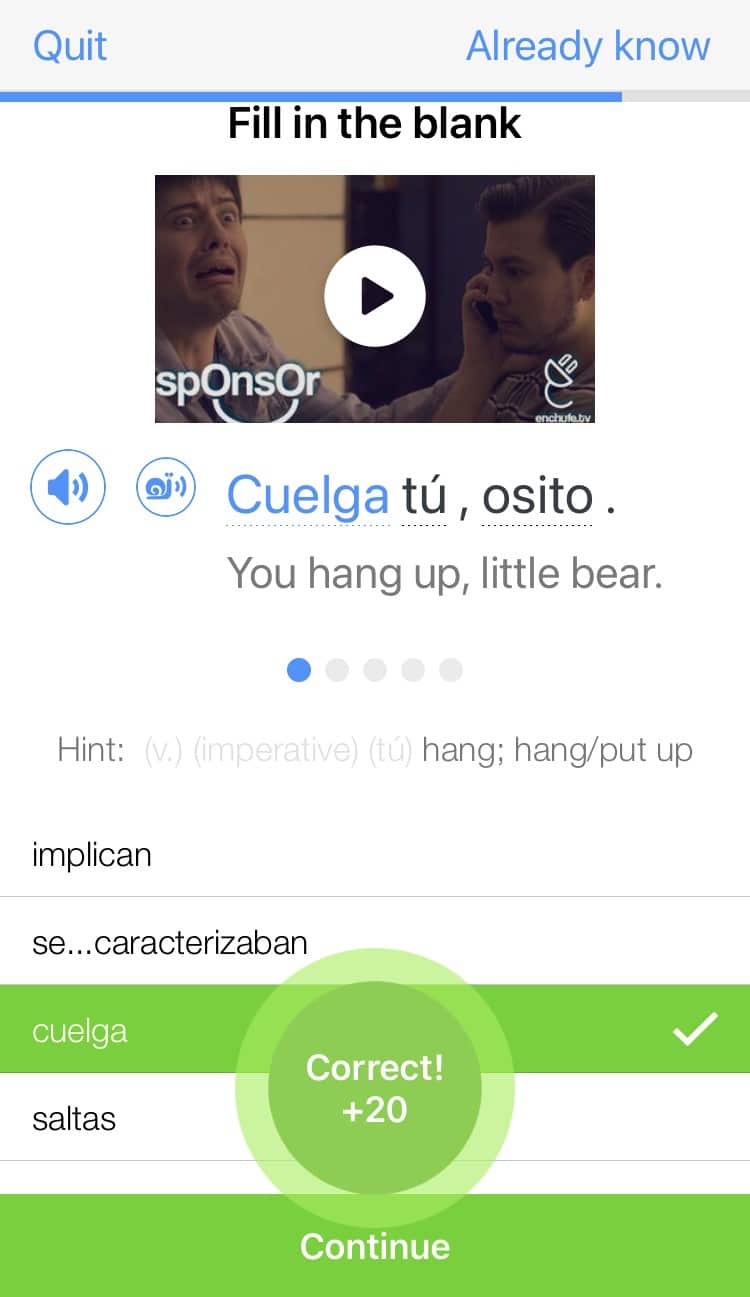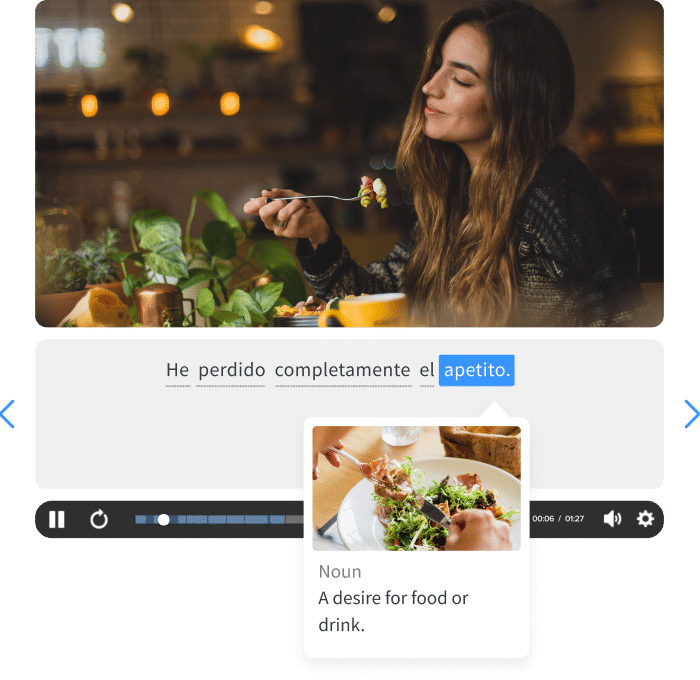
Spanish Prepositions and How to Use Them
Often, we’re taught that a preposition describes the place of a noun.
Prepositions also describe the relationship between a noun/pronoun and other words in a sentence.
Even if you’re a master of English prepositions, Spanish prepositions are another ballgame—the languages can be pretty different, after all.
Here, we’ll cover both simple and compound prepositions in Spanish.
Read on for 40 of the most common Spanish prepositions, plus when and how to use them.
Contents
- What is a Preposition?
- Simple Spanish Prepositions
- Compound Spanish Prepositions
- When and How to Use Spanish Prepositions
- Quiz on Spanish Prepositions
- Where to Practice Spanish Prepositions Online
- And One More Thing…
Download: This blog post is available as a convenient and portable PDF that you can take anywhere. Click here to get a copy. (Download)
What is a Preposition?
Simple Spanish Prepositions
Here are 23 of the most common Spanish prepositions. You’ll see that many of them have multiple meanings:
| Preposition | Meaning(s) | Example |
|---|---|---|
| a | to used to connect ir to an infinitive the personal a | Voy a la casa de mi amiga.
(I'm going to my friend's house.) Ellos van a nadar. (They're going to swim.) Tengo que llamar a mi mamá. (I have to call my mom.) |
| ante | before, in the face of (used in formal speech) | El acusado fue presentado ante un juez. (The defendant appeared before a judge.) |
| bajo | under, underneath under the rule of a political figure | El perro está bajo la mesa.
(The dog is under the table.) Bajo Kim Jong-un, Corea del Norte ha tenido muchos problemas. (Under Kim Jong-un, North Korea has had many problems.) |
| cabe | close to, next to *Rarely used in modern Spanish but can still be found in literature | La casa estaba cabe el bosque. (The house was next to the forest.) |
| con | with (accompaniment) with (to emphasize importance of something) | Voy a la fiesta con mis amigos.
(I'm going to the party with my friends.) Con todo lo que ha pasado en mi vida, me mantengo optimista. (With everything that's happened in my life, I remain an optimist.) |
| contra | against (opposed to) against (physical location) | No tengo nada contra él.
(I don't have anything against him.) La mesa está contra la pared. (The table is against the wall.) |
| de | from (indicating origin) from (indicating cause) of (indicating composition) of (indicating ownership) about | Mi abuela es de Canadá.
(My grandmother is from Canada.) Ella estaba gritando de tristeza. (She was screaming from sadness.) El plato está hecho de plástico. (The plate is made of plastic.) Este libro es de mi hermana. (This book is my sister's.) Él puede hablar de muchos temas. (He can talk about many topics.) |
| desde | since from | No la he visto desde ayer.
(I haven't seen her since yesterday.) Llamaré a mi madre desde tu casa. (I'll call my mother from your house.) |
| durante | during | Recuerde, no hable durante la película. (Remember, no talking during the movie.) |
| en | in (physical location) in (indicating manner) into by (indicating means) at (physical location) | Las cerezas están en la nevera.
(The cherries are in the fridge.) Mi padre habla en voz alta. (My dad speaks in a loud voice.) Puso la carta en el buzón. (He put the letter into the mailbox.) Voy a la biblioteca en coche. (I go to the library by car.) Estoy en el trabajo. (I'm at work.) |
| entre | between among | La puerta está entre las ventanas.
(The door is between the windows.) Encontré a mi hermana entre la multitud. (I found my sister among the crowd.) |
| hacia | towards about, around (approximate time) | Ellos corrieron hacia la salida del edificio.
(They ran towards the building's exit.) Voy a llegar hacia las dos de la tarde. (I'm going to arrive around two in the afternoon.) |
| hasta | until up to down to | Ellos se van a quedar con nosotros hasta mañana.
(They're going to stay with us until tomorrow.) Este ascensor tiene capacidad para hasta 10 personas. (This elevator has capacity for up to 10 people.) La temperatura bajó hasta los 10 grados. (The temperature went down to 10 degrees.) |
| mediante | through, by means of | Realizaremos la reunión mediante una videollamada. (We'll hold the meeting through a video call.) |
| para | for to, in order to | Le compré un regalo muy bonito para Navidad.
(I bought him a very nice gift for Christmas.) Para llegar a mi casa hay que subir una gran colina. (In order to get to my house, you have to go up a big hill.) |
| por | for by because of through per in (time period) | Muchas gracias por toda tu ayuda.
(Thank you so much for all your help.) Para ir al gimnasio, tienes que pasar por la farmacia. (To go to the gym, you have to pass by the pharmacy.) No fui a trabajar por la gripe. (I didn't go to work because of the flu.) Ellos pasaron por el pasillo. (They passed through the hallway.) Son quince dólares por libra. (They're 15 dollars per pound.) Estudio por la mañana. (I study in the morning.) |
| según | depending on according to | Según el tiempo, podemos ir a la playa.
(Depending on the weather, we can go to the beach.) Según su madre, la tienda cierra a las siete. (According to her mother, the store closes at 7:00.) |
| sin | without | Ahora, Elena puede hacer su tarea sin la ayuda de sus padres. (Now, Elena can do her homework without her parents' help.) |
| so | under *You'll likely only see so in literary contexts, or in expressions like so pretexto de (under the pretext/guise of) and so pena de (under the threat of). | So pretexto de trabajar hasta tarde, planeó una fiesta sorpresa para su novio. (Under the pretext of working late, she planned a surprise party for her boyfriend.) |
| sobre | on about over | Por favor, no pongas tu ropa sucia sobre la mesa.
(Please don't put your dirty clothes on the table.) Busco un libro sobre animales salvajes. (I'm looking for a book about wild animals.) El avión voló sobre el océano. (The plane flew over the ocean.) |
| tras | after | Mes tras mes, ella se siente cada vez más tranquila. (Month after month, she feels increasingly calmer.) |
| versus | versus, against | Este juego es el equipo de mi hermana versus el equipo de mi mejor amiga... ¡No sé a quién apoyar! (This game is my sister's team versus my best friend's team... I don't know who to root for!) |
| vía | through, by way of by, via | Viajé a Costa Rica vía los Estados Unidos.
(I traveled to Costa Rica by way of the United States.) La jefa le enviará el horario vía correo electrónico. (The boss will send you the schedule by email.) |
Compound Spanish Prepositions
Compound prepositions are groups of more than one word that, together, have the function of a preposition. In Spanish, they’re called locuciones preposicionales (prepositional phrases).
| Preposition | Meaning(s) | Example |
|---|---|---|
| a pesar de | despite | Mi hermano quiere hacer paracaidismo a pesar de su miedo a las alturas. (My brother wants to go skydiving despite his fear of heights.) |
| a través de | through | Nos comunicamos a través de mensajes de texto mientras él estaba de viaje. (We communicated through text messages while he was on a trip.) |
| al lado de | beside, next to | Me gusta mucho el restaurante que está al lado de la playa. (I really like the restaurant that's next to the beach.) |
| además de | besides, in addition to | Además de tocar el piano, ¿qué te gusta hacer? (Besides playing piano, what do you like to do?) |
| alrededor de | around (physical location) around (giving an approximation) | Hay flores alrededor de la iglesia.
(There are flowers around the church.) En la escuela, hay alrededor de 1500 estudiantes. (In the school, there are around 1500 students.) |
| cerca de | close to, near | El hotel está cerca de muchos restaurantes y tiendas. (The hotel is close to many restaurants and shops.) |
| debajo de | under, underneath | El gato estaba sentando debajo de la silla. (The cat was sitting underneath the chair.) |
| delante de | in front of | Solo mantente por delante de los otros corredores y estarás bien. (Just stay in front of the other runners and you'll be fine.) |
| dentro de | within inside | Hay muchos autobuses dentro de los límites de la ciudad.
(The company will get back to us within a week.) La compañía se pondrá en contacto con nosotros dentro de una semana. (There are many buses inside the city limits.) |
| detrás de | behind | Ella caminó detrás de su tía. (She walked behind her aunt.) |
| en cuanto a | as for, regarding | En cuanto a tus preguntas, las responderé al final de la presentación. (Regarding your questions, I'll answer them at the end of the presentation.) |
| en lugar de / en vez de | instead of | ¿Podrías hacerlo con miel en lugar de azúcar?
(Could you make it with honey instead of sugar?) Prefiero té en vez de café por la tarde. (I prefer tea instead of coffee in the afternoon.) |
| encima de | on top of | Tu sombrero está encima de la cama. (Your hat is on top of the bed.) |
| frente a | in front of | Hay un McDonald's frente a mi escuela. (There is a McDonald's in front of my school.) |
| fuera de | outside of | El perro esperó fuera del hospital. (The dog waited outside of the hospital.) |
| junto a | next to, by alongside | ¿Está su casa junto a la parada de autobús?
(Is their house next to the bus stop?) Durante la formación, trabajará junto a profesionales cualificados. (During the training, you will work alongside qualified professionals.) |
| lejos de | far from | El supermercado está lejos de mi casa (The supermarket is far from my house.) |
When and How to Use Spanish Prepositions
Voy al gimnasio después del trabajo. (I go to the gym after work.)
When we want to say “with me” or “with you” (the informal “you”) we say conmigo or contigo:
¿Quieres ir al baile conmigo? Porque me encantaría ir contigo. (Do you want to go to the dance with me? Because I’d love to go with you.)
Quiz on Spanish Prepositions
Now that you’ve learned many of the most common Spanish prepositions, it’s time to test your knowledge! Take the quiz below and refresh the page if you want to retake it.
Where to Practice Spanish Prepositions Online
So you’re now starting your endeavor to memorize every single Spanish preposition! Okay, maybe not all of them, but you do want them to start coming to you more easily.
Here are some great ways to practice Spanish prepositions:
- A quick and easy quiz to begin your preposition practice can be found at Spanish.ToLearnFree.com. Each question features a drop-down list of prepositions for you to choose from.
- The FluentU program offers a variety of Spanish videos with interactive subtitles, so you can immerse yourself in the language and learn prepositions straight from native speakers.
FluentU takes authentic videos—like music videos, movie trailers, news and inspiring talks—and turns them into personalized language learning lessons.
You can try FluentU for free for 2 weeks. Check out the website or download the iOS app or Android app.
P.S. Click here to take advantage of our current sale! (Expires at the end of this month)

- LearnSpanishFeelGood.com features 24 exercises to test your knowledge of prepositions. It includes activities like using prepositions of time and the difference between por and para.
- SpanishBoat.com offers a fill-in-the-blank quiz. You can use the word box to help you put the correct preposition in each blank, or try to do it straight from memory. Keep trying until you get them all right!
By investing time into learning prepositions and how they’re used, you can get more comfortable using them in different contexts.
Bookmark this page and come back to it whenever you have a few minutes to review.
You’ll soon feel much more confident speaking Spanish!
Download: This blog post is available as a convenient and portable PDF that you can take anywhere. Click here to get a copy. (Download)
And One More Thing…
If you've made it this far that means you probably enjoy learning Spanish with engaging material and will then love FluentU.
Other sites use scripted content. FluentU uses a natural approach that helps you ease into the Spanish language and culture over time. You’ll learn Spanish as it’s actually spoken by real people.
FluentU has a wide variety of videos, as you can see here:

FluentU brings native videos within reach with interactive transcripts. You can tap on any word to look it up instantly. Every definition has examples that have been written to help you understand how the word is used. If you see an interesting word you don’t know, you can add it to a vocab list.

Review a complete interactive transcript under the Dialogue tab, and find words and phrases listed under Vocab.

Learn all the vocabulary in any video with FluentU’s robust learning engine. Swipe left or right to see more examples of the word you’re on.

The best part is that FluentU keeps track of the vocabulary that you’re learning, and gives you extra practice with difficult words. It'll even remind you when it’s time to review what you’ve learned. Every learner has a truly personalized experience, even if they’re learning with the same video.
Start using the FluentU website on your computer or tablet or, better yet, download the FluentU app from the iTunes or Google Play store. Click here to take advantage of our current sale! (Expires at the end of this month.)




